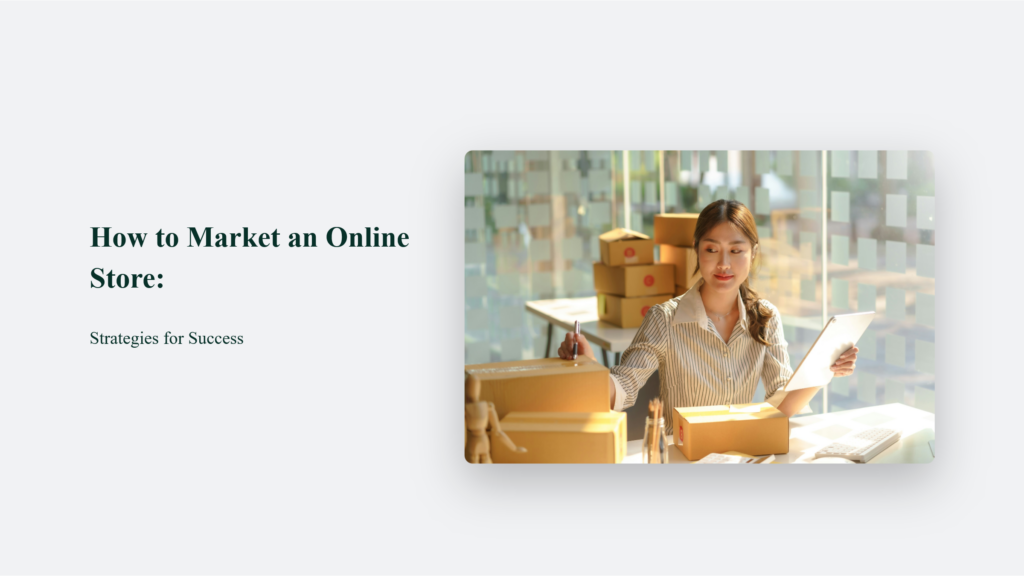
How to Market an Online Store: Strategies for Success
As Seen On
In today’s digital age, online stores are essential for businesses looking to expand their reach and increase sales. However, simply setting up an e-commerce website is not enough. You need to market your online store effectively to succeed in the competitive online marketplace.
This comprehensive guide will explore how to market an Online Store.

How to Market an Online Store:
Understanding Your Target Audience: The Key to Effective Marketing
Before embarking on any marketing strategy, it is essential to have a clear understanding of your target audience. Your target audience consists of the ideal customers who are most likely to be interested in your products or services. By gaining valuable insights into their needs, preferences, and behaviors, you can tailor your marketing efforts to reach and engage them effectively.
According to a study by MarketingSherpa, businesses that use buyer personas in their marketing strategies see a remarkable 171% increase in marketing-generated revenue compared to those that don’t. This statistic underscores the importance of understanding your target audience and crafting targeted marketing campaigns.
To gain a deep understanding of your target audience, consider the following steps:
- Create Buyer Personas: Develop detailed profiles of your ideal customers, including their demographics, psychographics, pain points, and goals. It will help you visualize and empathize with your target audience.
- Conduct Market Research: Gather data about your target market through surveys, focus groups, and online research. Analyze customer demographics, preferences, and behaviors to identify patterns and trends.
- Analyze Customer Data: Leverage your customer data, such as purchase history, website interactions, and social media engagement, to gain insights into your target audience’s behavior and preferences.
- Monitor Social Media: Engage with your target audience on social media platforms to understand their interests, concerns, and opinions. It will help you stay attuned to their evolving needs and preferences.
- Seek Feedback: Actively seek customer feedback through surveys, reviews, and customer support interactions. This valuable input can help refine your understanding of your target audience and improve your products or services accordingly.
By investing time and resources into understanding your target audience, you can develop marketing strategies that resonate with them on a deeper level. This knowledge will enable you to create targeted content, select the most effective marketing channels, and deliver personalized experiences that drive engagement and conversions.
Remember, your target audience is not a static entity. As their needs and preferences evolve, monitoring and adapting your understanding of your ideal customers is crucial. By staying attuned to their changing behaviors and expectations, you can ensure that your marketing efforts remain relevant and effective in the long run.
Optimize Your Online Store for Search Engines (SEO)
Optimizing your online store for search engines (SEO) is crucial for attracting organic traffic and driving sales. By implementing effective SEO strategies, you can improve your website’s visibility in search engine results pages (SERPs) and reach potential customers who are actively searching for products like yours. Here’s a comprehensive guide to help you optimize your online store for SEO.
Conduct Thorough Keyword Research
The foundation of a successful SEO strategy lies in identifying the right keywords to target. Conduct extensive keyword research to discover relevant and high-traffic keywords related to your products or niche. Use tools like Google Keyword Planner, SEMrush, or Ahrefs to find keywords with high search volume and low competition.
Consider targeting long-tail keywords, which are more specific and often have lower competition. Although these keywords may have a lower search volume, they tend to attract more qualified traffic with higher conversion potential. According to a study by Ahrefs, long-tail keywords account for 70% of all web searches.
Optimize On-Page Elements
Once you have identified your target keywords, integrate them naturally throughout your website’s on-page elements. It includes:
- Title Tags: Include your primary keyword in the title tag of each page, ideally at the beginning. Keep your title tags under 60 characters to ensure they display fully in search results.
- Meta Descriptions: Write compelling meta descriptions that incorporate your target keywords and entice users to click through to your website. Aim for meta descriptions between 150 and 160 characters.
- Header Tags: Use header tags (H1, H2, H3) to structure your content and include relevant keywords. Ensure each page has a unique H1 tag that includes your main keyword.
- Product Descriptions: Create unique, detailed, and keyword-rich product descriptions. Avoid using manufacturer-provided descriptions, as they can lead to duplicate content issues. Aim for descriptions between 200 and 300 words.
- Image Alt Text: Include descriptive alt text for all images, incorporating relevant keywords. It helps search engines understand the content of your images and improves accessibility.
Create High-Quality Content
In addition to optimizing product pages, create high-quality, informative content that targets your keywords and provides value to your audience. It can include blog posts, buying guides, tutorials, or FAQ pages. Regularly publishing fresh, relevant content helps establish your website as an authority in your niche and attracts organic traffic.
According to HubSpot, companies that publish 16+ blog posts per month get 3.5 times more traffic than those that publish 0-4 monthly posts. Aim to create content that is at least 1,000 words long, as longer content tends to rank better in search results.
Build Quality Backlinks
Backlinks from reputable websites are key to improving your website’s domain authority and search rankings. Focus on building high-quality, relevant backlinks through various strategies:
- Guest Posting: Contact websites in your niche and offer to write guest posts. Include a link back to your website within the content or author bio.
- Broken Link Building: Identify broken links on relevant websites and suggest your content as a replacement.
- Infographics: Create informative, visually appealing infographics and encourage others to share and link to them.
- Influencer Outreach: Collaborate with influencers in your niche and ask them to mention or link to your products or content.
A study by Backlinko found that the number of referring domains is the most important factor in Google ranking. Aim to build a diverse backlink profile from high-quality, relevant websites.
Optimize for Mobile
With the increasing use of mobile devices for online shopping, ensuring your online store is mobile-friendly is essential. Implement a responsive design that adapts to different screen sizes and provides a seamless user experience on smartphones and tablets.
Google’s mobile-first indexing prioritizes your website’s mobile version for indexing and ranking. Optimize your mobile site by ensuring fast loading times, easy navigation, and clear calls to action.
Monitor and Analyze Performance
Regularly monitor your website’s SEO performance using tools like Google Analytics and Google Search Console. Track your keyword rankings, organic traffic, and conversion rates. Analyze user behavior and identify areas for improvement. Use the insights gained from your analysis to refine your SEO strategy continuously.
Stay up-to-date with the latest SEO best practices and algorithm updates to ensure your online store remains competitive in search results.
By implementing these SEO strategies and consistently working to improve your online store’s search engine visibility, you can attract more organic traffic, build brand awareness, and ultimately drive more sales.

Leverage Social Media Marketing to Boost Your Online Store’s Visibility
Social media has become indispensable for businesses looking to connect with their target audience, increase brand awareness, and drive traffic to their online stores. With over 4.2 billion active social media users worldwide, leveraging social media marketing is crucial for the success of your e-commerce business.
By creating engaging content and running targeted social media campaigns, you can effectively promote your products and attract potential customers. A study by Sprout Social found that 78% of consumers are more willing to buy from a brand after having a positive experience with them on social media. It highlights the importance of building a strong social media presence and engaging with your audience.
To maximize the impact of your social media marketing efforts, consider the following strategies:
- Choose the right platforms: Not all social media platforms are created equal. It is essential to identify the platforms that align with your target audience and business goals. For example, if you’re targeting a younger demographic, platforms like Instagram and TikTok might be more effective than LinkedIn.
- Develop a consistent brand identity: Consistency is key in social media marketing. Create a cohesive brand voice and visual identity across all your social media profiles. This includes using the same logo, color scheme, and tone of voice in your posts and interactions.
- Share visually appealing content: Social media is a visual medium, and eye-catching visuals are crucial for capturing your audience’s attention. Share high-quality product images and videos that showcase your offerings in the best light. According to a study by Wyzowl, 84% of people have been convinced to buy a product or service after watching a brand’s video.
- Engage with your followers: Social media is a two-way conversation. Make sure to actively engage with your followers by responding to comments, messages, and reviews promptly and professionally. This helps build trust and fosters a sense of community around your brand.
- Run contests and giveaways: Social media contests and giveaways effectively increase brand exposure and encourage user-generated content. You can reach a wider audience and gain valuable social proof by incentivizing people to share your content or tag your brand.
- Collaborate with influencers: Influencer marketing has become a powerful tool for businesses looking to reach new audiences and gain credibility. Collaborate with influencers in your niche who align with your brand values and have a dedicated following. A survey by Mediakix found that 89% of marketers say ROI from influencer marketing is comparable to or better than other marketing channels.
By implementing these social media marketing strategies, you can effectively promote your online store, attract potential customers, and build a loyal following. Remember to continuously monitor your social media metrics, analyze your performance, and adjust your strategies to optimize your results.
Invest in Pay-Per-Click (PPC) Advertising
Pay-per-click (PPC) advertising is a highly effective way to drive targeted traffic to your online store. Platforms like Google Ads and Facebook Ads allow you to create ads that appear in front of users actively searching for or interested in similar products.
According to a study by WordStream, businesses that invest in PPC advertising see an average return on investment (ROI) of 200%. It means that for every $1 spent on PPC ads, businesses generate an average of $2 in revenue. Additionally, PPC ads can increase brand awareness by up to 80%
To maximize the impact of your PPC campaigns, consider the following strategies:
- Conduct thorough keyword research. Identify high-converting keywords and phrases relevant to your products and target audience. Tools like Google Keyword Planner and SEMrush can help you find the right keywords to target.
- Create compelling ad copy: Your ad copy should highlight your unique selling points and encourage clicks. Use powerful words and emotional triggers to grab attention and create a sense of urgency.
- Use eye-catching visuals: Incorporate high-quality product images and videos in your ads to showcase your offerings and grab attention. Visual content can increase click-through rates by up to 80%.
- Set up targeted ad groups: Organize your ads into targeted ad groups based on specific product categories or customer segments. It allows you to deliver more relevant and personalized ads to your audience.
- Monitor and optimize your campaigns: Monitor your PPC campaigns and analyze performance metrics like click-through rates (CTR) and conversion rates. Use this data to optimize your ads, landing pages, and targeting for better results.
When done right, PPC advertising can be a game-changer for your online store. By targeting the right keywords, creating compelling ads, and continuously optimizing your campaigns, you can drive highly qualified traffic to your website and boost your sales.
However, it’s important to note that PPC advertising requires ongoing management and optimization to achieve the best results. If you’re new to PPC, consider working with a professional agency or taking online courses to learn the ins and outs of this powerful marketing strategy.
By investing time and resources into PPC advertising, you can take your online store to the next level and achieve your business goals faster.
Implement Email Marketing Campaigns
Email marketing is a powerful tool for online stores to nurture leads, build customer loyalty, and drive repeat sales. By collecting email addresses from website visitors and customers, you can create targeted email campaigns that promote your products, share valuable content, and offer exclusive discounts. According to a study by the Direct Marketing Association, email marketing has an average ROI of 122%, making it one of the most effective marketing channels for businesses.
To maximize the impact of your email marketing efforts, consider the following strategies:
- Create a compelling opt-in offer: Encourage visitors to sign up for your email list by offering a compelling incentive, such as a discount code or free shipping. A study by Sumo found that offering a discount can increase email sign-ups by up to 50%. Ensure your opt-in form is prominently displayed on your website and communicates the benefits of subscribing.
- Segment your email list: Not all customers are the same, so it’s essential to segment your email list based on customer behavior, preferences, and purchase history. You can increase engagement and conversions by delivering personalized and relevant content to each segment. According to a study by Mailchimp, segmented email campaigns have a 14.31% higher open rate and a 100.95% higher click-through rate than non-segmented campaigns.
- Design visually appealing email templates: Your email templates should align with your brand identity and effectively showcase your products. Use high-quality images, clear calls to action, and a responsive design that looks great on both desktop and mobile devices. A study by Campaign Monitor found that emails with a single clear call to action increased clicks by 371%.
- Use catchy subject lines and engaging copy: Your subject line is the first thing recipients see, so making it compelling and attention-grabbing is crucial. Use actionable language, personalization, and a sense of urgency to increase open rates. Once recipients open your email, use engaging copy highlighting your products’ benefits and encouraging them to take action. A study by Experian found that personalized subject lines can increase open rates by up to 26%.
- Automate your email campaigns: Automated email campaigns based on specific triggers, such as abandoned cart reminders or post-purchase follow-ups, can help you recover lost sales and build customer loyalty. According to a study by Moosend, automated abandoned cart emails have an average open rate of 45% and a click-through rate of 21%. By setting up automated email sequences, you can save time and ensure that your customers receive timely and relevant communications.

Offer Exceptional Customer Service:
Offering exceptional customer service is crucial for building a positive reputation and fostering customer loyalty in your online store. According to a study by Microsoft, 96% of consumers say customer service is important in their choice of loyalty to a brand. To enhance your customer support, provide multiple channels such as live chat, email, and phone, ensuring prompt and professional responses.
A Zendesk survey found that 69% of customers appreciate the convenience of having multiple support options. Additionally, it offers clear and detailed product information, including sizing charts and care instructions, to minimize confusion and returns. Implement a hassle-free return and exchange policy, as 67% of shoppers check the returns page before making a purchase, according to a UPS study.
Gather customer feedback and reviews regularly to identify areas for improvement and show customers that their opinions matter. By prioritizing exceptional customer service, you can boost customer satisfaction, loyalty, and your online store’s success.
The Bottom Line:
Marketing an online store requires a multi-faceted approach that combines various strategies and techniques. By understanding your target audience, optimizing your website for search engines, leveraging social media marketing, investing in PPC advertising, implementing email marketing campaigns, and offering exceptional customer service, you can effectively promote your online store and drive sales.
Remember, marketing is an ongoing process that requires continuous effort and refinement. Regularly analyze your marketing performance, stay up-to-date with industry trends, and adapt your strategies to stay ahead of the competition.
Frequently Asked Questions:
What is the best social media platform for marketing an online store?
The best social media platform for your online store depends on your target audience and business niche. Facebook, Instagram, and Pinterest are popular choices for e-commerce businesses, but it’s essential to research where your ideal customers spend their time online.
How much should I invest in PPC advertising?
The amount you invest in PPC advertising depends on your budget, competition, and advertising goals. It’s important to start with a modest budget and gradually increase your investment as you optimize your campaigns and see positive returns.
How often should I send marketing emails to my subscribers?
The frequency of your email campaigns depends on your business and audience preferences. Generally, sending 1-2 emails per week is a good starting point, but be sure to monitor your open rates and adjust your frequency accordingly to avoid overwhelming your subscribers.
Konger
Up until working with Casey, we had only had poor to mediocre experiences outsourcing work to agencies. Casey & the team at CJ&CO are the exception to the rule.
Communication was beyond great, his understanding of our vision was phenomenal, and instead of needing babysitting like the other agencies we worked with, he was not only completely dependable but also gave us sound suggestions on how to get better results, at the risk of us not needing him for the initial job we requested (absolute gem).
This has truly been the first time we worked with someone outside of our business that quickly grasped our vision, and that I could completely forget about and would still deliver above expectations.
I honestly can't wait to work in many more projects together!
Disclaimer
*The information this blog provides is for general informational purposes only and is not intended as financial or professional advice. The information may not reflect current developments and may be changed or updated without notice. Any opinions expressed on this blog are the author’s own and do not necessarily reflect the views of the author’s employer or any other organization. You should not act or rely on any information contained in this blog without first seeking the advice of a professional. No representation or warranty, express or implied, is made as to the accuracy or completeness of the information contained in this blog. The author and affiliated parties assume no liability for any errors or omissions.

